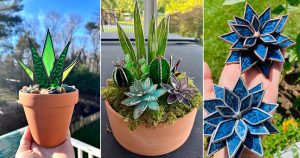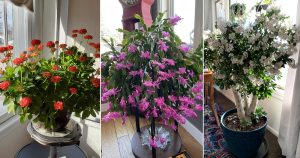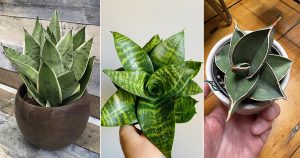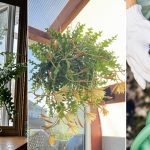You often hear this that “People change color”, but what if we say that there are some Succulent Plants That Change Colors, too!
Yes, there are some magical succulent plants that change colors! When you think of succulents, you probably picture green, right? Well, some of these little guys can turn beautiful shades of red, pink, or purple when given the right conditions. So, let’s find out their true colors!
Succulent Plants That Change Colors
1. Crassula capitella ‘Campfire’

Crassula capitella ‘Campfire’ is like having a campfire in your garden. In full sun and cooler nights, its leaves blaze bright red-orange. During less stressful times, it stays green, but it’s ready to light up when the season changes. This transformation starts in late summer and continues through fall. Plus, the color change is due to the plant’s response to stress from sunlight and temperature drops.
Crassula capitella ‘Campfire’ is known for its fast growth and ability to fill out garden spaces quickly. It can become invasive in some climates, so keep an eye on its spread or you can plant it in a container.
2. Aeonium ‘Zwartkop’
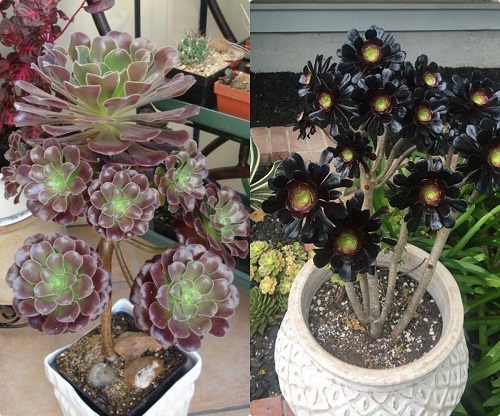
Aeonium ‘Zwartkop’ is known for its rosette shape. Under intense sunlight and cooler weather, its leaves turn a deep purple. In the summer, it’s more of a moody green, but come fall, it’s all about that dark, brooding look. This succulent prefers full sun, so make sure it gets plenty of light to maintain its striking color.
Note: Watch out for overwatering—this plant prefers to dry out between waterings.
3. Echeveria ‘Perle von Nurnberg’

Echeveria ‘Perle von Nurnberg’ is your pastel dream come true. Its leaves turn pink and purple with bright light and cooler temps. It’s like your garden’s version of a unicorn. This succulent prefers bright, indirect light and a bit of cool air to show off its colors. Too much direct sun can cause sunburn, so find a spot that offers just the right balance.
4. Sedum rubrotinctum ‘Aurora’

Sedum rubrotinctum ‘Aurora’, or Pink Jelly Beans, is as sweet as it sounds. This succulent is pretty hardy, which is great for beginners. Sedum rubrotinctum ‘Aurora’ produces small, yellow flowers in the spring. Its leaves mix pink and green, turning more pink with lots of sunlight and less water. Stress this plant a bit, and you’ll get vivid pink tips that look good enough to eat (but don’t!).
Caution: Just be careful with its leaves that are toxic if ingested, so keep it away from pets and children.
5. Kalanchoe luciae

Kalanchoe luciae, aka Flapjack, sports paddle-shaped leaves that turn red around the edges with bright sun. This change pops most in winter, making it look like it’s got a rosy blush. The leaves are thick and fleshy, helping the plant store water.
Place it in a sunny spot and watch the edges turn a beautiful red. It also has yellow blooms in spring. Be mindful of overwatering—its thick leaves retain a lot of moisture.
6. Sempervivum tectorum
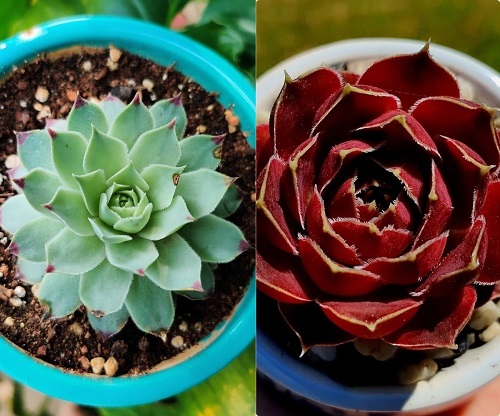
Sempervivum tectorum, or Hens and Chicks, can switch from green to deep red depending on the season. Cool temps and bright sunlight in fall and winter bring out its red rosettes, adding year-round color to your garden. This succulent is incredibly hardy and can survive in various conditions.
It’s also known for producing offsets, or “chicks,” which makes it easy to propagate and share with friends. Sempervivum tectorum is often used in rock gardens and green roofs because of its durability and low maintenance needs.
7. Aloe ‘Christmas Carol’
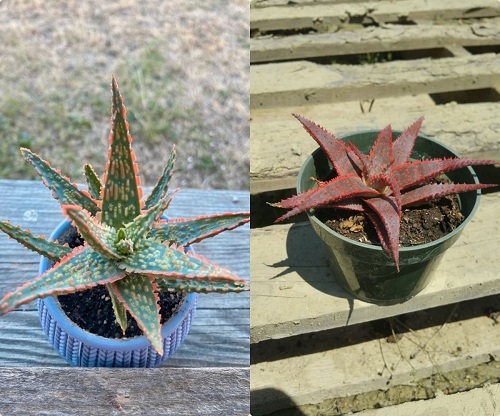
Aloe ‘Christmas Carol’ gets its festive red hue in bright sunlight and cooler temps. Think of it as a holiday decoration that comes to life when winter hits. Its deep red color is a natural reaction to stress from sun exposure and temperature changes. If you notice the red fading, it might need more sunlight. In summer, it may turn greener, so place it in a sunny spot and enjoy the seasonal show.
Aloe ‘Christmas Carol’ is also popular for its tubular flowers that bloom in the fall to winter. But, be careful with its spines—they can be quite sharp!
8. Euphorbia tirucalli

Euphorbia tirucalli, also known as Fire Sticks or Pencil Cactus, turns bright red and orange in full sun and cool weather. It’s like your garden’s version of fireworks, with stems that light up in winter. This plant is quite drought-tolerant and does well with minimal water. Be careful, though—the sap can be irritating to the skin, so handle it with care.
Fact: Euphorbia tirucalli is often used in traditional medicine in Africa for various ailments, though it should never be used without expert guidance due to its toxic sap. And, always wear gloves when handling this plant to avoid skin irritation from the sap.
9. Crassula ovata

Crassula ovata, commonly known as Jade Plant, can surprise you with a beautiful reddish hue on its leaves’ edges when exposed to bright sunlight and cooler temperatures. This succulent is a symbol of good luck and prosperity. While it’s typically green, stress from sun exposure and temperature changes brings out its red highlights, especially in the winter months. Just, avoid overwatering as it can lead to root rot. Let the soil dry out completely between waterings.
10. Pachyphytum oviferum

We have saved the best one for the last! Pink Moonstone Succulent is named for its resemblance to polished moonstones, with a smooth and shiny surface. Its plump, pastel pink leaves can blush to deeper shades of pink and purple when exposed to bright sunlight and cooler temperatures. Apart from that, just be careful when you handle it as its leaves can easily detach if handled too roughly.
Isn’t it cool how these succulents change colors like magic? With the right sunlight, temperature, soil, watering, and container, you can see your plants transform. Give it a try and watch your garden turn into a colorful one. You can share your stories and tips in the comments!

